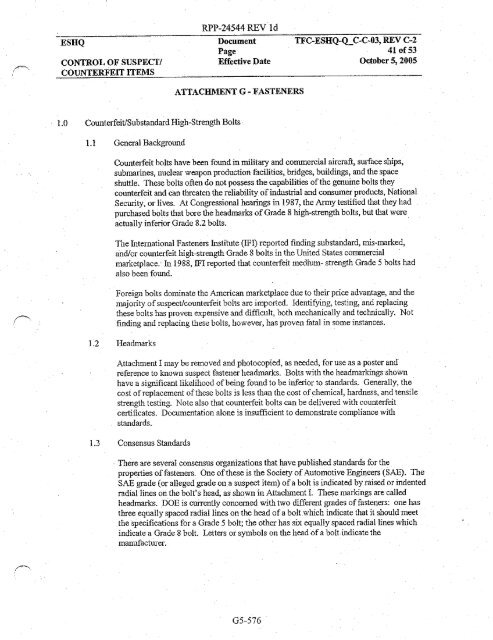View Document Here - Hanford Site
View Document Here - Hanford Site
View Document Here - Hanford Site
Create successful ePaper yourself
Turn your PDF publications into a flip-book with our unique Google optimized e-Paper software.
ESHQ<br />
RPP-24544 REV Id<br />
<strong>Document</strong> TFC-ESHQ-Q_C-C-03, REV C-2<br />
Page<br />
41 of 53<br />
CONTROL OF SUSPECT/<br />
COUNTERFEIT ITEMS<br />
Effective Date October 5, 2005<br />
LO<br />
Counterfeit/Substandard High-Strength Bolts<br />
1.1 General Background<br />
ATTACHMENT G - FASTENERS<br />
Counterfeit bolts have been found in military and commercial aircraft, surface ships,<br />
submarines, nuclear weapon production facilities, bridges, buildings, and the space<br />
shuttle. These bolts often do not possess the capabilities of the genuine bolts they<br />
counterfeit and can threaten the reliability of industrial and consumer products, National<br />
Security, or lives. At Congressional hearings in 1987, the Army testified that they had<br />
purchased bolts that bore the headmarks of Grade 8 high-strength bolts, but that were<br />
actually inferior Grade 8.2 bolts.<br />
The International Fasteners Institute (IFI) reported finding substandard, mis-marked,<br />
and/or counterfeit high-strength Grade 8 bolts in the United States commercial<br />
marketplace. In 1988, IFI reported that counterfeit medium- strength Grade 5 bolts had<br />
also been found.<br />
Foreign bolts dominate the American marketplace due to their price advantage, and the<br />
majority of suspect/counterfeit bolts are imported. Identifying, testing, and replacing<br />
these bolts has proven expensive and difficult, both mechanically and technically. Not<br />
finding and replacing these bolts, however, has proven fatal in some instances.<br />
I.2 Headmarks<br />
Attachment I may be removed and photocopied, as needed, for use as a poster and<br />
reference to known suspect fastener headmarks. Bolts with the headmarkings shown<br />
have a significant likelihood of being found to be inferior to standards. Generally, the<br />
cost of replacement of these bolts is less than the cost of chemical, hardness, and tensile<br />
strength testing. Note also that counterfeit bolts can be delivered with counterfeit<br />
certificates. <strong>Document</strong>ation alone is insufficient to demonstrate compliance with<br />
standards.<br />
1.3 Consensus Standards<br />
There are several consensus organizations that have published standards for the<br />
properties of fasteners. One of these is the Society of Automotive Engineers (SAE). The<br />
SAE grade (or alleged grade on a suspect item) of a bolt is indicated by raised or indented<br />
radial lines on the bolt's head, as shown in Attachment I. These markings are called<br />
headmarks. DOE is currently concerned with two different grades of fasteners: one has<br />
three equally spaced radial lines on the head of a bolt which indicate that it should meet<br />
the specifications for a Grade 5 bolt; the other has six equally spaced radial lines which<br />
indicate a Grade 8 bolt. Letters or symbols on the head of a bolt indicate the<br />
manufacturer.<br />
G5-576

















